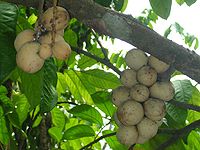Valencia, Negros Oriental
Template:Infobox Philippine municipality Valencia is a municipality in the province of Negros Oriental, Philippines. It is located 9.4 km west of Dumaguete, the largest city and capital of the province. According to the national 2000 census, Valencia has a population of 24,365 people in 4,860 households.
The mayor of Valencia is Rodolfo Gonzalez, Jr., who was elected in 2001 and re-elected in 2004.
People and culture
Our Lady of the Abandoned is the patroness of Valencia, and her feast day is celebrated annually every October 12 with the town fiesta. The fiesta is an official non-working holiday for the town.
Economy


The economy of Valencia is largely based on agriculture. Major products include abaca, copra, corn, flowers, vegetables, root crops, and exotic fruits such as lanzones and rambutan.
The municipality is also the site of a geothermal power station operated by the National Power Corporation. It generates electricity that is supplies the needs of Negros, Panay, and part of Cebu. The municipal government receives royalties from the power station which are used to subsidize electricity costs of local residents. Each household receives a monthly rebate of P600 on their electricity bill.
Many residents also work in the nearby city of Dumaguete.
Tourism attractions in the municipality include Forest Camp, Casaroro Falls, the Philippine-American-Japanese Amity Shrine, and the World War II museum.
Geography
Valencia occupies an area of approximately 150 km², located 9.4 km west of the provincial capital, Dumaguete. The town is 65% mountainous, with elevation ranging from 200 to 500 meters above sea level. The climate in the municipality is relatively cool, especially in areas of high elevation.
The town is politically subdivided into 24 barangays.
|
|
History
Valencia was originally named Ermita, which means "a secluded place", due to its being a refuge from marauding Muslim pirates. In 1856 it was renamed to Nueva Valencia by Spanish colonizers, in honor of its parish priest Fr. Matias Villamayor from Valencia, Spain.
In 1920 it was renamed Luzuriaga in behalf of Don Carlos Luzuriaga, a delegate from Negros island to the Philippine Legislature who promised town officials he would work hard to help improve the town. The promise was unfulfilled, prompting local leaders in 1941 to agree to revert to the old name Nueva Valencia.
In 1948, right after World War II, then Mayor Rodolfo "Odol" V. Gonzalez Sr. and his Municipal Council officially adopted the name Valencia for the town, dropping out "Nueva".
